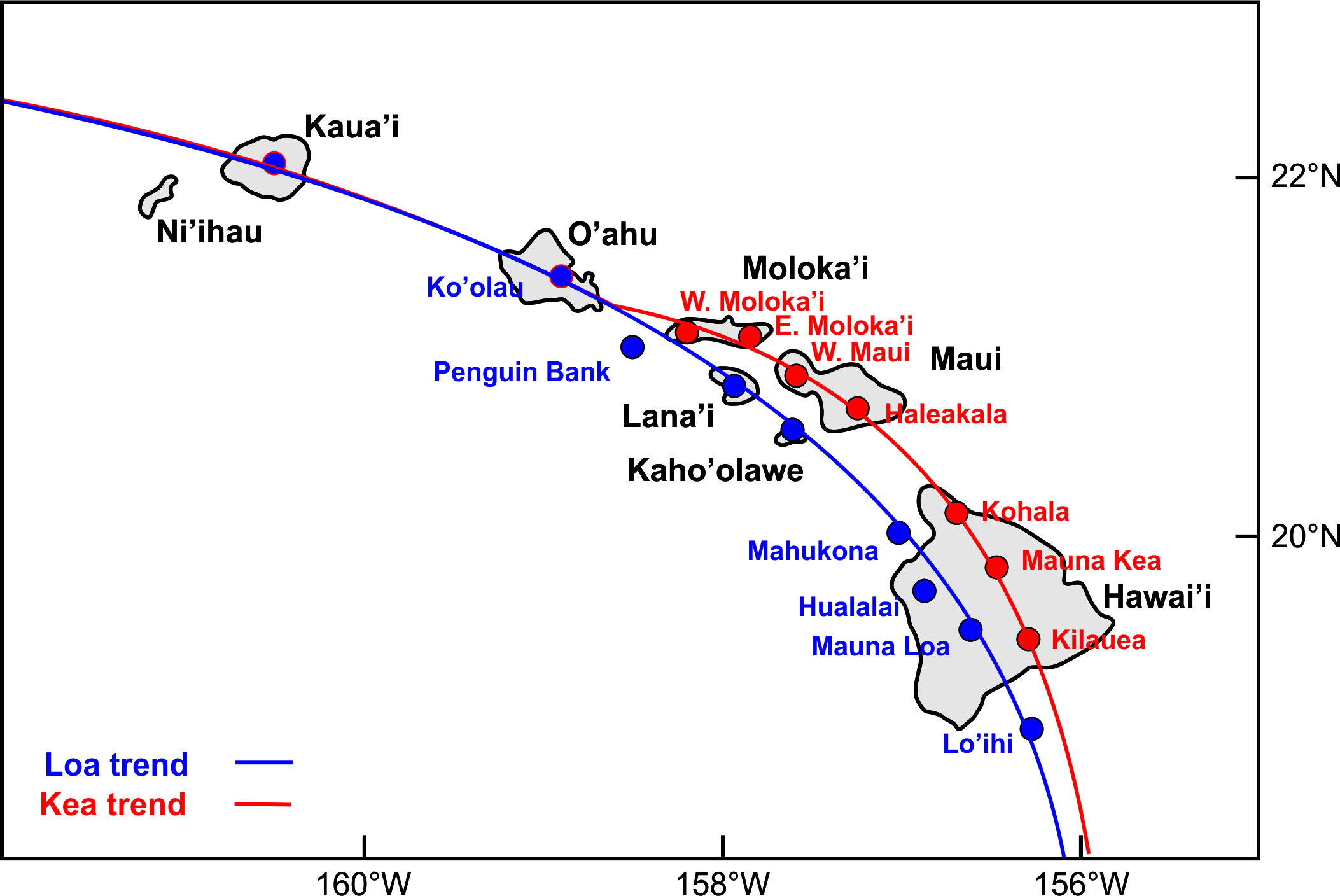Hawaiian volcanoes - Part 2: The Hawaiian Hotspot
Hello,
After the introduction to Hawaiian volcanism in my last post I would like to talk about the life cycle of a Hawaiian volcano.
This life cycle can be observed along the 3,200 km long northwest-trending Hawaiian Ridge and the 2,600 km long north trending Emperor Ridge. Only the island chains of the Hawaiian Ridge are currently risen above sea level. The Emperor Ridge is a chain of volcanoes lying beneath the ocean, known as seamounts.
So before we dive into the detailed steps in the life cycle of a Hawaiian volcano we need to explore the amazing feature that lead to the formation of these volcanic ridges:

Figure 1. Map of the Hawaii-Emperor seamount chain with seafloor topography.
commons.wikimedia.org
All volcanoes of the Hawaiian Ridge and the Emperor Ridge have been formed by the same geological process. The Canadian geophysicist John Tuzo Wilson was the first to propose that the Hawaiian Islands had been formed where the Pacific plate moved slowly west-northwest over a hotspot, the surface expression of a plume. Later on, Jason Morgan extended Wilsons’s theory by including the Emperor seamounts into the genetic interpretation as well. On the map in Figure 1 you can see a change in orientation between the two ridges. This is the result of a change in motion of the Pacific plate, which occurred as a result of changes in the orientation of centers of sea-floor spreading at the south-eastern side of the plate, pushing the plate underneath the Eurasian and North American plates in the north-east, where the Emperor Ridge disappears into the Kuril-Kamtschatka Trench.

Figure 2. Cross section of the Hawaiian hot spot.
Wikipedia.org
A plume is an uprising of buoyant mantle material, originating from as deep as the Mantle-Core boundary. This material gets transported into the Upper Mantle at great enough speeds to retain most of their heat. This addition of heat causes melting in the Upper Mantle. The resulting melt impinges the oceanic curst of the Pacific plate and flows out as lava on the ocean floor, forming, over the cause of millions of years, the Hawaiian volcanoes.
The chains of islands have been created in different pulses, where periods of volcanic activity have been separated by relatively quiet periods. These pulses then created the visible chain of islands as the Pacific plate carried away the older islands to the northwest. An important observation is the fact that the present islands are not arranged in a single row. Instead they form two parallel rows of volcanoes that are about 40 km apart. These two rows formed on each side of the hotspot.

Figure 3. Map of recent Hawaiian volcanism, highlighting the two volcanic rows.
Modified after Jones et al. (2017).
Summary
Locally fixed hotspot volcanism has continuously formed volcanoes on an ever moving Pacific plate. This has caused the formation of two extensive Ridges of volcanoes. The emerged Hawaiian Ridge and the submerged Emperor Seamount Ridge, which range in total over 5,800 km. They display magmatic activity in the centre of the Pacific Ocean that has been active for least 70 million years.
Sources
- Jones, T.D., Davies, D.R., Campbell, I.H., Iaffaldano, G., Yaxley, G., Kramer, S.C., Wilson, C.R. (2017). The concurrent emergence and causes of double volcanic hotspot tracks on the Pacific plate. Nature 545, 472–476
- Tilling, R.I., Heliker, C., and Swanson D.A. (2010). Eruptions of Hawaiian volcanoes— past, present, and future: U.S. Geological Survey General Information Product 117
- Zeilinga de Boer, J. and Sanders, D.T., (2002). Volcanoes in Human History: The Far-reaching Effects of Major Eruptions. Princeton University Press
- http://manoa.hawaii.edu/coe/kulia/publications/nsf/Hawaii_evolution_main_shield_Kahua_Ao_HANDOUTS.pdf
- Power Point presentations from the University of Hawai'i available at http://www2.hawaii.edu/~nasir/
- https://en.wikipedia.org/wiki/Evolution_of_Hawaiian_volcanoes
- https://en.wikipedia.org/wiki/Hawaii_hotspot
- https://en.wikipedia.org/wiki/John_Tuzo_Wilson
- https://en.wikipedia.org/wiki/W._Jason_Morgan
- https://commons.wikimedia.org/wiki/Category:Geology_of_Hawaii
Great post... Thanks for sharing this...
You just planted 0.44 tree(s)!
Thanks to @sooflauschig
We have planted already 3887.79 trees
out of 1,000,000
Let's save and restore Abongphen Highland Forest
in Cameroonian village Kedjom-Keku!
Plant trees with @treeplanter and get paid for it!
My Steem Power = 20751.18
Thanks a lot!
@martin.mikes coordinator of @kedjom-keku